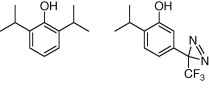Diazirine

Diazirines are a class of organic molecules consisting of a carbon bound to two nitrogen atoms, which are double-bonded to each other, forming a cyclopropene-like ring. Upon irradiation with ultraviolet light, diazirines form reactive carbenes, which can insert into C-H, N-H, and O-H bonds.[1] Hence, diazirines have grown in popularity as small photo-reactive crosslinking reagents. They are often used in photoaffinity labeling studies to observe a variety of interactions, including ligand-receptor, ligand-enzyme, protein-protein, and protein-nucleic acid interactions.[2]
Synthesis
A number of methods exist in the literature for the preparation of diazirines, which begin from a variety of reagents.
Synthesis from Ketones
Generally, synthetic schemes that begin with ketones involve conversion of the ketone with the desired substituents to diaziridines. These diaziridenes are then subsequently oxidized to form the desired diazirines.
Diaziridines can be prepared from ketones by oximation, followed by tosylation (or mesylation), and then finally by treatment with ammonia. Generally, oximation reactions are performed by reacting the ketone with hydroxylammonium chloride under heat in the presence of a base such as pyridine.[3][4] Subsequent tosylation or mesylation of the alpha substituted oxygen with tosyl or mesyl chloride in the presence of base yields the tosyl or mesyl oxime.[5] The final treatment of the tosyl or mesyl oxime with ammonia produces the diaziridine.[1][2][5][6]

Alternatively, diaziridines can be produced directly by the reaction of ketones with ammonia in the presence of an aminating agent such as a chloramine or hydroxyl amine O-sulfonic acid.[7]
Diaziridines can be oxidized to diazirines by a number of methods. These include oxidation by chromium based reagents such as the Jones oxidation,[8] oxidation by iodine and triethylamine,[3] oxidation by silver oxide,[9] oxidation by oxalyl chloride,[5] or even electrochemical oxidation on a platinum-titanium anode.[10]

Synthesis via Graham Reaction
Alternatively, diazirines can be formed in a one-pot process using the Graham reaction. In these schemes, amidines can be directly converted to diazirines by hypohalite oxidation.[11] This reaction yields a halogenated diazirine, which can further be modified.
The resulting aforementioned halodiazirine can undergo an exchange reaction to further functionalize the diazirene. In these reactions, anion nucleophiles, such as tetra-n-butylammonium fluoride or methoxytetra-n-butylammonium can replace the halogen substituents yielding a fluorodiazirine or methoxydiazirine respectively.[12]

Chemistry
Upon irradiation with UV light, diazirines form reactive carbene species. The carbene may exist in the singlet form, in which the two free electrons occupy the same orbital, or the triplet form, with two unpaired electrons in different orbitals.

Triplet vs Singlet Carbene Products
The substituents on the diazirine affect which carbene species is generated upon irradiation and subsequent photolytic cleavage. Diazirine substituents that are electron donating in nature can donate electron density to the empty p-orbital of the carbene that will be formed, and hence can stabilize the singlet state. For example, phenyldiazirine produces phenylcarbene in the singlet carbene state[13] whereas p-nitrophenylchlorodiazirine or triflourophenyldiazirine produce the respective triplet carbene products.[14][15]
Electron donating substituents can also encourage photoisomerization to the linear diazo compound, rather than the singlet carbene, and hence these compounds are unfavorable for use in biological assays.[16] On the other hand, triflouroaryldiazirines in particular show favorable stability and photolytic qualities[16] and are most commonly used in biological applications.[1]

Carbenes produced from diazirines are quickly quenched by reaction with water molecules,[17] and hence yields for photoreactive crosslinking assays are often low. Yet, as this feature minimizes unspecific labeling, it is actually an advantage of using diazirines.
Use in Photoreactive Crosslinking
Diazirines are often used as photoreactive crosslinking reagents, as the reactive carbenes they form upon irradiation with UV light can insert into C-H, N-H, and O-H bonds. This results in proximity dependent labeling of other species with the diazirine containing compound.
Diazirines are often preferred to other photoreactive crosslinking reagents due to their smaller size, longer irradiation wavelength, short period of irradiation required, and stability in the presence of various nucleophiles, and in both acidic and basic conditions.[18] Benzophenones, which form reactive triplet carbonyl species upon irradiation, often require long periods of irradiation which can result in non-specific labeling, and moreover are often inert to various polar solvents.[19] Aryl azides require a low wavelength of irradiation, which can damage the biological macromolecules under investigation.
Examples in receptor labeling studies
Diazirines are widely used in receptor labeling studies. This is because diazirine-containing analogs of various ligands can be synthesized and incubated with their respective receptors, and then subsequently exposed to light to produce reactive carbenes. The carbene will covalently bond to residues in the binding site of the receptor. The carbene compound may include a bioorthogonal tag or handle by which the protein of interest can be isolated. The protein can then be digested and sequenced by mass spectrometry in order to the identity which residues the carbene containing ligand is bound to, and hence the identity of the binding site in the receptor.
Examples of diazirines used in receptor labeling studies include:
- The discovery of a brassinosteroid receptor for brassinosteroid plant hormones by Kinoshita et al. Researchers used a plant hormone analog with a diazirine crosslinking moiety and a biotin tag for isolation to identity the new receptor.[20] This study led to a number of similar studies conducted with regards to other plant hormones.

- The discovery of novel non-CB1/CB2 cannabinoid receptors using anandamide analog probes containing a diazirine group by Balas et al.[21]
- The binding cavity of the hypnotic agent propofol in the GABAA receptor using a diazirine containing propofol analog.[22]

Examples in enzyme-substrate studies
In a manner analogous to receptor labeling, diazirine containing compounds that are analogs of natural substrates have also been used to identify binding pockets of enzymes. Examples include:
- The synthesis of a diazirine containing analog of etoposide, a widely used cancer drug targeting topoisomerase II, which holds promise for the identification of the etoposide binding site.[23]

- The discovery that caprolactam-type gamma-secretase inhibitors target the SPP subunit of the gamma-secretase, which has been implicated in Alzheimer's disease.[24]
Examples in nucleic acid studies
Diazirines have been used in photoaffinity labeling experiments involving nucleic acids as well. Examples include:
- Incorporation of a diazirine moiety on a nucleoside sugar in a DNA polymer to investigate interactions between the minor groove of DNA and DNA polymerases.[25]

- Incorporation of a diazirine moiety on a nucleoside base in a DNA polymer to investigate the mode of DNA repair by proteins.[26]

Diazirines have also been used to study protein lipid interactions, for example the interaction of various sphingolipids with proteins in vivo.[27][27]
References
- 1 2 3 Dubinsky, Luba; Krom, Bastiaan P.; Meijler, Michael M. (2012-01-15). "Diazirine based photoaffinity labeling". Bioorganic & Medicinal Chemistry. Chemical Proteomics. 20 (2): 554–570. doi:10.1016/j.bmc.2011.06.066.
- 1 2 Sinz, Andrea (2007-04-01). "Investigation of protein-ligand interactions by mass spectrometry". ChemMedChem. 2 (4): 425–431. doi:10.1002/cmdc.200600298. ISSN 1860-7187. PMID 17299828.
- 1 2 Burkard, Nadja; Bender, Tobias; Westmeier, Johannes; Nardmann, Christin; Huss, Markus; Wieczorek, Helmut; Grond, Stephanie; von Zezschwitz, Paultheo (2010-04-01). "New Fluorous Photoaffinity Labels (F-PAL) and Their Application in V-ATPase Inhibition Studies". European Journal of Organic Chemistry. 2010 (11): 2176–2181. doi:10.1002/ejoc.200901463. ISSN 1099-0690.
- ↑ Song, Zhiquan; Zhang, Qisheng (2009-11-05). "Fluorous Aryldiazirine Photoaffinity Labeling Reagents". Organic Letters. 11 (21): 4882–4885. doi:10.1021/ol901955y. ISSN 1523-7060.
- 1 2 3 Kumar, Nag S.; Young, Robert N. (2009-08-01). "Design and synthesis of an all-in-one 3-(1,1-difluoroprop-2-ynyl)-3H-diazirin-3-yl functional group for photo-affinity labeling". Bioorganic & Medicinal Chemistry. 17 (15): 5388–5395. doi:10.1016/j.bmc.2009.06.048.
- ↑ Gu, Min; Yan, Jianbin; Bai, Zhiyan; Chen, Yue-Ting; Lu, Wei; Tang, Jie; Duan, Liusheng; Xie, Daoxin; Nan, Fa-Jun (2010-05-01). "Design and synthesis of biotin-tagged photoaffinity probes of jasmonates". Bioorganic & Medicinal Chemistry. 18 (9): 3012–3019. doi:10.1016/j.bmc.2010.03.059.
- ↑ Dubinsky, Luba; Jarosz, Lucja M.; Amara, Neri; Krief, Pnina; Kravchenko, Vladimir V.; Krom, Bastiaan P.; Meijler, Michael M. "Synthesis and validation of a probe to identify quorum sensing receptors". Chemical Communications (47). doi:10.1039/b917507e.
- ↑ Wagner, Gerald; Knoll, Wolfgang; Bobek, Michael M.; Brecker, Lothar; van Herwijnen, Hendrikus W. G.; Brinker, Udo H. (2010-01-15). "Structure−Reactivity Relationships: Reactions of a 5-Substituted Aziadamantane in a Resorcin[4]arene-based Cavitand". Organic Letters. 12 (2): 332–335. doi:10.1021/ol902667a. ISSN 1523-7060.
- ↑ Al-Omari, Mohammad; Banert, Klaus; Hagedorn, Manfred (2006-01-01). "Bi-3H-diazirin-3-yls as Precursors of Highly Strained Cycloalkynes". Angewandte Chemie International Edition. 45 (2): 309–311. doi:10.1002/anie.200503124. ISSN 1521-3773.
- ↑ Vedenyapina, M. D.; Kuznetsov, V. V.; Nizhnikovskii, E. A.; Strel’tsova, E. D.; Makhova, N. N.; Struchkova, M. I.; Vedenyapin, A. A. (2006-11-01). "Electrochemical synthesis of pentamethylenediazirine". Russian Chemical Bulletin. 55 (11): 2013–2015. doi:10.1007/s11172-006-0544-0. ISSN 1066-5285.
- ↑ Graham, W. H. (1965-10-01). "The Halogenation of Amidines. I. Synthesis of 3-Halo- and Other Negatively Substituted Diazirines1". Journal of the American Chemical Society. 87 (19): 4396–4397. doi:10.1021/ja00947a040. ISSN 0002-7863.
- ↑ Moss, Robert A. (2006-04-01). "Diazirines: Carbene Precursors Par Excellence". Accounts of Chemical Research. 39 (4): 267–272. doi:10.1021/ar050155h. ISSN 0001-4842.
- ↑ Zhang, Yunlong; Burdzinski, Gotard; Kubicki, Jacek; Platz, Matthew S. (2008-12-03). "Direct Observation of Carbene and Diazo Formation from Aryldiazirines by Ultrafast Infrared Spectroscopy". Journal of the American Chemical Society. 130 (48): 16134–16135. doi:10.1021/ja805922b. ISSN 0002-7863.
- ↑ Noller, Bastian; Poisson, Lionel; Maksimenka, Raman; Gobert, Oliver; Fischer, Ingo; Mestdagh, J. M. (2009-04-02). "Ultrafast Dynamics of Isolated Phenylcarbenes Followed by Femtosecond Time-Resolved Velocity Map Imaging". The Journal of Physical Chemistry A. 113 (13): 3041–3050. doi:10.1021/jp810974m. ISSN 1089-5639.
- ↑ Noller, Bastian; Hemberger, Patrick; Fischer, Ingo; Alcaraz, Christian; Garcia, Gustavo A.; Soldi-Lose, Héloïse. "The photoionisation of two phenylcarbenes and their diazirine precursors investigated using synchrotron radiation". Physical Chemistry Chemical Physics. 11 (26). doi:10.1039/b823269e.
- 1 2 Brunner, J.; Senn, H.; Richards, F. M. (1980-04-25). "3-Trifluoromethyl-3-phenyldiazirine. A new carbene generating group for photolabeling reagents". The Journal of Biological Chemistry. 255 (8): 3313–3318. ISSN 0021-9258. PMID 7364745.
- ↑ Wang, Jin; Kubicki, Jacek; Peng, Huolei; Platz, Matthew S. (2008-05-01). "Influence of Solvent on Carbene Intersystem Crossing Rates". Journal of the American Chemical Society. 130 (20): 6604–6609. doi:10.1021/ja711385t. ISSN 0002-7863.
- ↑ Hatanaka, Yasumaru; Sadakane, Yutaka (2002-03-01). "Photoaffinity labeling in drug discovery and developments: chemical gateway for entering proteomic frontier". Current Topics in Medicinal Chemistry. 2 (3): 271–288. doi:10.2174/1568026023394182. ISSN 1568-0266. PMID 11944820.
- ↑ Prestwich, Glenn D.; Dormán, György; Elliott, John T.; Marecak, Dale M.; Chaudhary, Anu (1997-02-01). "Benzophenone Photoprobes for Phosphoinositides, Peptides and Drugs". Photochemistry and Photobiology. 65 (2): 222–234. doi:10.1111/j.1751-1097.1997.tb08548.x. ISSN 1751-1097.
- ↑ Kinoshita, Toshinori; Caño-Delgado, Ana; Seto, Hideharu; Hiranuma, Sayoko; Fujioka, Shozo; Yoshida, Shigeo; Chory, Joanne. "Binding of brassinosteroids to the extracellular domain of plant receptor kinase BRI1". Nature. 433 (7022): 167–171. doi:10.1038/nature03227.
- ↑ Balas, Laurence; Durand, Thierry; Saha, Sattyabrata; Johnson, Inneke; Mukhopadhyay, Somnath (2009-02-26). "Total Synthesis of Photoactivatable or Fluorescent Anandamide Probes: Novel Bioactive Compounds with Angiogenic Activity". Journal of Medicinal Chemistry. 52 (4): 1005–1017. doi:10.1021/jm8011382. ISSN 0022-2623.
- ↑ Hall, Michael A.; Xi, Jin; Lor, Chong; Dai, Shuiping; Pearce, Robert; Dailey, William P.; Eckenhoff, Roderic G. (2010-08-12). "m-Azipropofol (AziPm) a Photoactive Analogue of the Intravenous General Anesthetic Propofol". Journal of Medicinal Chemistry. 53 (15): 5667–5675. doi:10.1021/jm1004072. ISSN 0022-2623. PMC 2917171
 . PMID 20597506.
. PMID 20597506. - ↑ Chee, Gaik-Lean; Yalowich, Jack C.; Bodner, Andrew; Wu, Xing; Hasinoff, Brian B. (2010-01-15). "A diazirine-based photoaffinity etoposide probe for labeling topoisomerase II". Bioorganic & Medicinal Chemistry. 18 (2): 830–838. doi:10.1016/j.bmc.2009.11.048. PMC 2818565
 . PMID 20006518.
. PMID 20006518. - ↑ Fuwa, Haruhiko; Takahashi, Yasuko; Konno, Yu; Watanabe, Naoto; Miyashita, Hiroyuki; Sasaki, Makoto; Natsugari, Hideaki; Kan, Toshiyuki; Fukuyama, Tohru (2007-06-01). "Divergent Synthesis of Multifunctional Molecular Probes To Elucidate the Enzyme Specificity of Dipeptidic γ-Secretase Inhibitors". ACS Chemical Biology. 2 (6): 408–418. doi:10.1021/cb700073y. ISSN 1554-8929.
- ↑ Liebmann, Meike; Di Pasquale, Francesca; Marx, Andreas (2006-12-04). "A New Photoactive Building Block for Investigation of DNA Backbone Interactions: Photoaffinity Labeling of Human DNA Polymerase β". ChemBioChem. 7 (12): 1965–1969. doi:10.1002/cbic.200600333. ISSN 1439-7633.
- ↑ Winnacker, Malte; Breeger, Sascha; Strasser, Ralf; Carell, Thomas (2009-01-05). "Novel Diazirine-Containing DNA Photoaffinity Probes for the Investigation of DNA-Protein-Interactions". ChemBioChem. 10 (1): 109–118. doi:10.1002/cbic.200800397. ISSN 1439-7633.
- 1 2 Yamamoto, Tetsuya; Hasegawa, Hiroko; Hakogi, Toshikazu; Katsumura, Shigeo (2006-11-01). "Versatile Synthetic Method for Sphingolipids and Functionalized Sphingosine Derivatives via Olefin Cross Metathesis". Organic Letters. 8 (24): 5569–5572. doi:10.1021/ol062258l. ISSN 1523-7060.